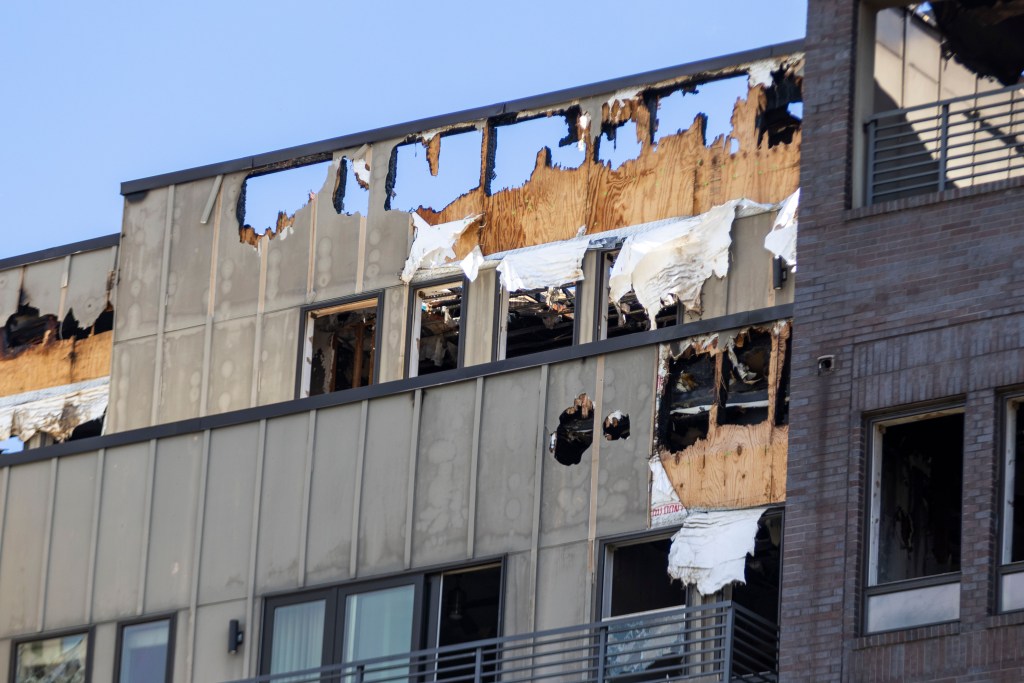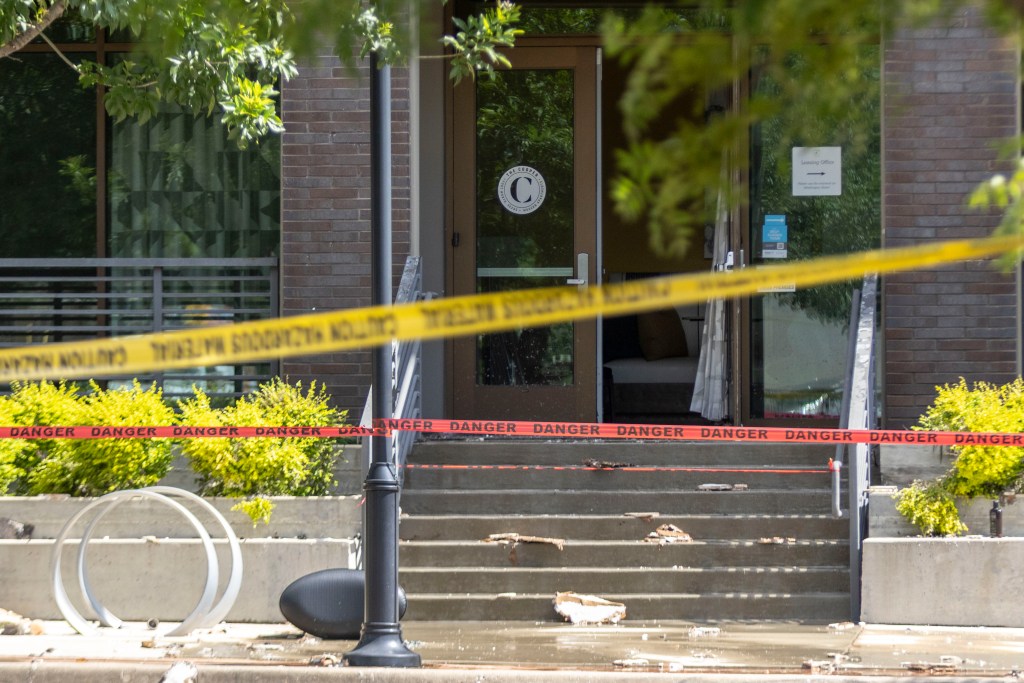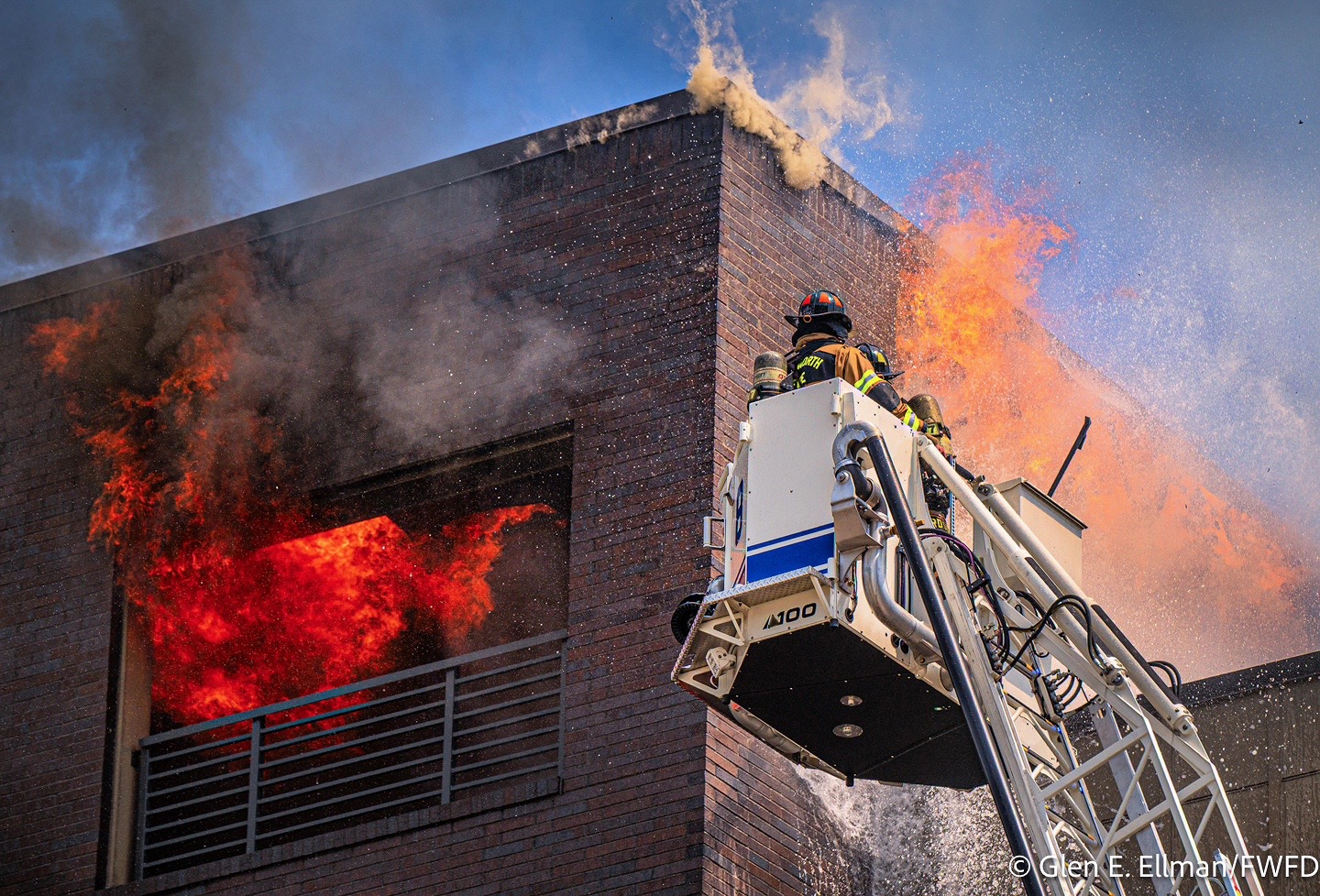Fort Worth’s six-alarm fire at The Cooper is teaching the city some lessons about firefighting in mid-rise buildings that have increasingly popped up in recent years.
The Fort Worth Fire Department and neighboring cities sent 80 engines and trucks and 272 firefighters to The Cooper, according to an incident report. The fire displaced more than 800 residents of the apartment complex.
The department is conducting a post-incident review, but Fort Worth Fire Chief Jim Davis said there was no evidence of anything substandard at The Cooper. However, a rubber material in the roof combined with the day’s heat made battling the fire more difficult, officials said.
The Cooper, a $65 million five-story, 390-unit modern apartment building at 1001 W. Rosedale St., opened in 2020 in the Near Southside. The construction is akin to that of many similar buildings that popped up in Fort Worth as Cowtown began its growth spurt toward becoming the country’s 11th-largest city. The complex was designed by GFF and built by general contractor KWA Construction, both well-known companies that have been involved in many major projects in the area.
Firefighters used chainsaws to cut through the roof — a three-layer system consisting of metal decking, a layer of insulation and one of a water-repellant rubber membrane on top, with wooden trusses supporting the structure — to create vents to allow the heat from inside to escape and redirect the fire so firefighters could fight it from beneath.
The rubber membrane is made up of an ethylene propylene diene terpolymer, or EPDM, that is widely used in low-slope buildings, such as The Cooper, according to the EPDM Roofing Association, an industry trade group.
The rubber gummed up the saw blades in the intense midday temperatures and the heat generated by the cutting. That forced the firefighters to use packing knives, as they’re trained, to cut through the inch of rubber, followed by tools like shovels to peel it back, Davis said. That allowed them to then cut through the decking, creating one vent about the size of a large conference room table, he said. They cut a second vent in a nearby wall.
The roofing system is one of a number of options allowed by city code, which tends to follow broadly accepted building codes in the North Texas area. Even though the roof presented what Davis called a “challenge,” he said he had no problem with it.
“I personally have no heartache or no issue with that particular type of roof,” he said. “I just know that what it does is it creates us a different, unique challenge.”
 The damage to the upper floors is seen at The Cooper on June 25, 2025, in Fort Worth. (Mary Abby Goss | Fort Worth Report)
The damage to the upper floors is seen at The Cooper on June 25, 2025, in Fort Worth. (Mary Abby Goss | Fort Worth Report)
The Cooper’s roofing system is one the Fort Worth Fire Department is familiar with, Davis said.
“We see a lot of them, and they appear to work well,” he said. “They keep the water out.”
Davis pointed to heat as a particular factor in the fire. It was hot that day, with temperatures reaching over 90 degrees. As a result, firefighters couldn’t stay on the roof very long to fight the fire and the rubberized covering on the roof began to break down, causing issues in working with the material, he said.
“Had it not been pushing 100-degree temperatures, and had (the fire) not been running and traveling the way it was, (I think) we would have gotten to it,” he said.
Nur Yazdani, a professor in the civil engineering department at the University of Texas at Arlington, is a structural engineer with expertise in fire damage.
He said the rubber roofs are durable, lasting 30 to 40 years, but melt at high temperatures of about 300 degrees Fahrenheit.
“It’s touted as a good product, and it lasts a while and provides durability, but at the same time, it’s not a good thing when you can’t get into the attic in that kind of environment where the fire is,” he said.
Fires can quickly get as hot as 1,000 degrees Fahrenheit, he said.
Shawn Michael, president of Lon Smith Roofing, endorsed the rubber material as common in roofing.
“They are very good and durable, particularly for flat roof environments,” he said. “I had never really considered how they would operate under a condition when a building was on fire, but I can see where they might be more difficult to handle under those conditions.”
Code reviews coming up
Evan Roberts, the city’s building official, said he expects The Cooper incident to come up as Fort Worth reviews its codes for 2027.
“When we are considering adopting a new code, we always do go back” and review potentially relevant cases, he said in an interview. “We look across the industry, local incidents and national incidents, and say is there something here that we need to drill down on further? Is this creating an unsafe situation?”
Such examination of The Cooper incident hasn’t occurred yet, he said. “That’s a little farther down the road.”
 Caution tape blocks off an entrance littered with rubble June 25, 2025, at The Cooper in Fort Worth. (Mary Abby Goss | Fort Worth Report)
Caution tape blocks off an entrance littered with rubble June 25, 2025, at The Cooper in Fort Worth. (Mary Abby Goss | Fort Worth Report)
In February 2022, an apartment/hotel complex under construction in Oklahoma City burned for several hours. Reports cited the rubber roofing materials shielded the fire underneath from the 2 million gallons of water applied to the fire, according to a report in Firefighter Nation.
Roberts noted the codes are not about mandating choices.
“It’s not intended to limit materials,” he said. “It’s intended to provide minimum requirements for the safe installation of said materials. So it’s really the designer’s choice. As with all construction decisions, it’s a balancing act between long-term cost versus upfront lifetime carry costs and how it works. We don’t necessarily get involved in that calculus.”
The fire department has trained extensively on mid-rise buildings of four to seven stories, with a department-wide training in March, and The Cooper fire, at six stories, put that training into action.
Challenges presented by such buildings often include underground parking, big courtyards, apartments on the street and away from it, and limited access, Davis said.
“It’s like taking a high-rise and putting it on its side,” Davis said. “It’s not 20 stories in the air, but now it’s 500 feet long down the street. There’s limited access points. We’ve got to figure out hose stretches, got to figure out water supply, water pressure.”
Water supply and pressure were not issues in The Cooper fire, he said.
‘Couldn’t get ahead of it fast enough’
The cause of the fire, attributed to an electrical anomaly with arcing, started around an air conditioning unit on the roof. It was spotted by a technician working for an electrical contractor who was trouble-shooting an electrical problem in the air conditioning unit and called 911 when he smelled smoke and saw fire.
The call was dispatched as an apartment fire, with four engines, two trucks and two battalion chiefs responding, department spokesman Craig Trojacek said.
Firefighters discovered a fire running beneath the roof decking in a void space — an empty, enclosed, unused space near the roof and air conditioner. One group of firefighters went to the roof to confront the blaze. A second group began evacuating the building, Davis said.
Using drones and thermal imaging, they spotted the fire beneath the roof and behind a wall on the roof, Davis said.
“We couldn’t get ahead of it fast enough because it was running,” Davis said.
It likely took about 30 minutes to cut the two vents on top of the building, Davis said. Commanders called the firefighters off the roof for their safety, he said.
“It is underneath our people’s feet here, it’s in the wall here, and it’s running in this spot,” Davis said, showing the thermal imaging pictures. “They’ve already cut some holes in it. We need to now let the fire start opening that roof up for us, because it’s too dangerous for us to put people above it and take the risk of them falling through.”
Almost three hours after the 911 call, the sixth alarm was called.
Richard Hicks, assistant fire chief, noted the building and fire codes Fort Worth operates under were last updated in 2021, published in 2022, and will be revisited in 2027.
“Our standards are very high nationally,” Hicks said.
According to the June 27 incident report, fire crews cleared the scene at 8:19 p.m. June 24 — 30 hours after the original 911 call.
Other lessons to be learned from The Cooper fire
Along with reviewing the fire codes, Fire Chief Davis said he anticipated the incident review would address:
- Consistent on-site communication with apartment management. “They’re doing their thing, but we also need to know how many people are in this building, how you communicate with those people.” That was a “constant” with The Cooper fire, he said. “My perfect world, somebody’d be standing right there” with fire commanders, “and that’s not realistic. … We need access to the building. We have a master key; it’s called a sledge hammer. But it’d be a whole lot easier if we can just get a master key.” A building maintenance man walked around The Cooper during the incident with firefighters, helping them get access to units and providing them with information about the layout, he said.
- A system for ensuring everybody in an incident like the one at The Cooper is accounted for. “And how do we account for their pets?” Davis said. A reunification center for people and their pets is one potential answer, he said.
- Sustaining firefighting operations over multiple hours. “How we get simple things like where can some of these guys go to the bathroom. Can we get somebody for food if they’ve been out there for six, eight, 12 hours?” Davis said. A Fort Worth volunteer organization called the Red Helmets, which supports Fort Worth fire operations, was on-site at The Cooper fire, Davis said.
Scott Nishimura is a senior editor for the Documenters program at the Fort Worth Report. Reach him at scott.nishimura@fortworthreport.org.
Bob Francis is business editor for the Fort Worth Report. Contact him at bob.francis@fortworthreport.org.
At the Fort Worth Report, news decisions are made independently of our board members and financial supporters. Read more about our editorial independence policy here.
Related
Fort Worth Report is certified by the Journalism Trust Initiative for adhering to standards for ethical journalism.
Republish This Story
Republishing is free for noncommercial entities. Commercial entities are prohibited without a licensing agreement. Contact us for details.
